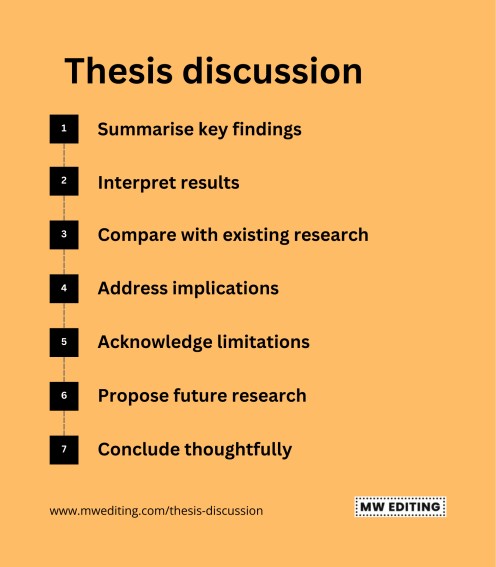The thesis discussion is a component of an academic thesis where the researcher interprets and analyses the findings of the study. It connects the results to the research questions or hypotheses, explores their significance and situates them within the context of existing literature. The discussion often addresses implications, limitations and potential areas for future research, providing a critical examination of how the findings contribute to the field.
The discussion is typically located after the results section and before the conclusion in a thesis. Its length varies depending on the discipline and length of the thesis but generally constitutes about 15–25% of the total word count.
This blog post explains the purpose of the thesis discussion, its importance in interpreting findings and situating them within the existing body of knowledge. The post also outlines a step-by-step approach for writing a cohesive and impactful discussion section, including a detailed template with guiding questions. Additionally, it explains how professional copyediting and proofreading services can enhance the clarity and professionalism of the thesis discussion.
- Purpose of thesis discussion
- Structure of thesis discussion
- Template for writing a thesis discussion
- Using editing services
- Resources
Purpose of thesis discussion
The purpose of the thesis discussion is to present research findings: interpret them, highlight their significance and contextualise them within the existing body of knowledge. Its importance lies in providing a critical analysis that explains how the results answer the research questions, contribute to the field and address theoretical or practical gaps. Additionally, the discussion identifies limitations and suggests directions for future research, demonstrating the study’s relevance and guiding subsequent work.
Structure of thesis discussion
The structure of a thesis discussion typically includes 7 components relevant to the thesis findings: their restatement and interpretation, comparison with existing literature, implications, limitations and suggestions for future research.
- Restatement of key findings: Briefly summarise the main results to provide context for the discussion.
- Interpretation of findings: Analyse the results, explaining their significance and how they address the research questions or hypotheses.
- Comparison with existing literature: Discuss how the findings align or contrast with prior studies, situating the research within the broader academic field.
- Implications: Explore the practical, theoretical or policy implications of the findings.
- Limitations: Acknowledge the study’s limitations, such as methodological constraints and how they might affect the interpretation of results.
- Suggestions for future research: Propose areas where further investigation is needed based on the study’s findings and limitations.
- Conclusion: Provide a brief summary that ties the discussion to the study’s objectives and emphasises the key contributions.

Template for writing a thesis discussion
1. Summarise key findings
Start by restating the main results of your study in relation to the research questions or hypotheses. Avoid repeating the results section word-for-word. Instead, focus on highlighting the most important findings that are relevant to the discussion. This step ensures the reader has a clear understanding of the results before moving into their interpretation.
To summarise the key findings, answer the following questions:
- What are the key findings of the study?
- How do these findings relate to the research questions or hypotheses?
- Which results are most significant for the discussion?
2. Interpret results
Provide an in-depth analysis of what the findings mean and why they matter. Discuss how the results answer the research questions and address the research problem. Explore unexpected findings and their possible explanations and clarify the broader significance of your results. Avoid speculative claims unless they are supported by evidence or are clearly stated as hypotheses.
To interpret the results, answer the following questions:
- What do the findings reveal about the research problem?
- How do the results address the research objectives?
- Are there any unexpected findings and what might explain them?
- What is the broader significance of these findings?
3. Compare with existing research
Situate your findings within the context of previous studies. Identify similarities, differences or contradictions between your results and the literature. This comparison helps validate your findings, shows how they contribute to existing knowledge and demonstrates your awareness of the broader academic landscape. Use this step to highlight gaps your study has filled or areas where further debate may be necessary.
To compare the findings with existing research, answer the following questions:
- How do the findings align with previous studies?
- Are there any contradictions or differences compared to existing literature? Why might these exist?
- What new insights do your findings provide to the field?
4. Address implications
Examine the implications of your results for theory, practice or policy. For theoretical contributions, discuss how your findings support or challenge existing models or frameworks. For practical implications, outline how your results can be applied in real-world contexts, such as industry, education or healthcare. This step is crucial for demonstrating the relevance and impact of your research.
To address the implications of the findings, answer the following questions:
- What theoretical contributions do these findings make?
- How can the findings be applied in real-world settings?
- What are the practical or policy-related implications of the results?
5. Acknowledge limitations
Be transparent about the limitations of your study to maintain credibility and demonstrate critical thinking. Limitations may include sample size, methodology constraints, biases or challenges in data collection. Discuss how these limitations might affect the validity or generalisability of your findings, but do not overly diminish the significance of your work.
To acknowledge limitations of the findings, answer the following questions:
- What were the key limitations of the study (e.g. sample size, methodology)?
- How might these limitations affect the interpretation of the results?
- Are there any biases or factors that could influence the findings?
- What measures were taken to mitigate these limitations?
6. Propose future research
Based on the gaps or limitations identified, suggest areas for further investigation. Be specific about what aspects require more attention and how future studies could build on your findings. Proposing future research shows that your study is part of an ongoing scholarly conversation and provides a foundation for subsequent work.
To propose future research, answer the following questions:
- What gaps in knowledge remain after this study?
- How could future research build upon these findings?
- What specific questions or issues should future studies address?
- Are there new methods or approaches that could improve upon your research?
7. Conclude thoughtfully
End the discussion with a concise summary of its main points. Reaffirm how your findings address the research objectives, contribute to the field and advance understanding of the topic. This conclusion ties together the discussion and reinforces the value of your research. Avoid introducing new information or results at this stage.
To conclude the thesis discussion, answer the following questions:
- How do the findings address the original research objectives?
- What are the key contributions of the study to the field?
- What is the overall significance of the research?
Using editing services
Copyediting and proofreading services prepare the discussion and the entire thesis for submission by refining the language, structure and presentation of the document.
Copyediting ensures clarity and coherence by improving sentence structure, ensuring logical flow and refining the articulation of ideas in the discussion and across the thesis. It corrects grammatical errors, standardises terminology and referencing and ensures consistency in style and formatting to meet academic or institutional guidelines.
Proofreading, as the final review step, focuses on surface-level errors such as grammar, spelling, punctuation and typographical mistakes, ensuring the document is polished and free from inconsistencies. Together, these services enhance readability, professionalism and adherence to submission standards, making the thesis clear, impactful and ready for academic evaluation.
Copyediting and proofreading services ensure the discussion and the entire thesis are polished, coherent and submission-ready by focusing on the following areas:
- Clarity and coherence: Ensuring the arguments in the discussion are clearly articulated, logically structured and easy to follow, improving the overall readability.
- Grammar, spelling and punctuation: Correcting errors in language usage to present a professional and academically sound document.
- Consistency: Standardising terminology, formatting and referencing to ensure alignment with style guides and academic conventions.
- Flow and structure: Refining transitions between sections and ensuring that ideas flow logically, enhancing the overall structure of the thesis.
- Accuracy: Verifying that data, citations and references in the discussion and throughout the thesis are accurate and appropriately presented.
- Conciseness: Eliminating redundancy and ensuring the writing is succinct while preserving the meaning and impact of the discussion.
- Adherence to guidelines: Ensuring the thesis meets institutional or publication requirements for style, formatting and structure, avoiding potential rejections or delays in submission.
Resources
Recommended resources for writing a thesis discussion:
Books
- The Craft of Research by Booth, Colomb, and Williams offers practical advice on structuring and presenting research findings.
- They Say/I Say by Graff and Birkenstein helps with argumentation and positioning your findings within academic discourse.
- Writing Your Dissertation in Fifteen Minutes a Day by Joan Bolker provides tips on academic writing and overcoming challenges.
Podcasts
- How to Write a PhD in a Hundred Steps covers all aspects of thesis writing, including the discussion section.
- PhD Talk discusses practical tips for academic writing and research.
- The Thesis Whisperer offers insights and advice for doctoral students tackling different sections of their thesis.
Platforms and tools
- EndNote, Mendeley or Zotero for managing references and citations effectively.
- Hemingway helps with grammar and style, ensuring clarity and precision in writing.
- NVivo, a qualitative data analysis tool that can assist in presenting complex findings clearly.
- Purdue OWL offers detailed guidance on academic writing, including sections like discussions.
Key takeaways
In summary, the thesis discussion interprets research findings, demonstrates their significance and situates them within the broader academic context. Its importance lies in connecting the results to research objectives, addressing implications and identifying limitations while suggesting directions for future studies. Structured into 7 key components — summarising findings, interpreting results, comparing with literature, discussing implications, acknowledging limitations, proposing future research, and concluding thoughtfully — the thesis discussion ensures a logical and cohesive analysis.
Contact me if you are an academic author looking for editing or indexing services. I am an experienced editor offering a free sample edit and an early bird discount.


